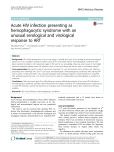Acute HIV infection presenting as hemophagocytic syndrome with an unusual serological and virological response to ART
Background:
HIV clinical presentation in the acute stage is variable and some of its virological and immunological aspects are not completely understood. Most cases of HIV- associated reactive hemophagocytic syndrome have been reported in patients with advanced stages of HIV and to our knowledge, there are only 8 cases in the English literature presenting during acute HIV infection, most in East Asia, being this the first case in a European patient.
Case presentation:
We report a case of a European Caucasian 27- year old woman with a primary HIV- infection presenting with extremely low CD4+ T cell count who developed a haemophagocytic syndrome after starting ART and in whom we documented a very unusual serological and virological response, characterized by an impaired HIV- antibody production and a 12 month time frame to reach an undetectable viral load, despite no evidence of resistance.
Conclusions:
This case report apart from describing an unusual clinical presentation of an acute HIV infection as hemophagocytic syndrome provides useful information that might contribute for understanding some subtle issues in acute HIV infection, namely the dynamics of virological and immunological aspects after antiretroviral therapy initiation.
Keywords:
HIV, Acute infection, Haemophagocytic syndrome
Autoři:
Rita Veiga Ferraz 1,2*; Ana Cláudia Carvalho 1,2; Fernando Araújo 3; Carmo Koch 3; Cândida Abreu 1,2; António Sarmento 1,2
Působiště autorů:
Infectious Diseases Department, Centro Hospitalar de São João, Alameda Prof. Hernâni Monteiro, Porto, Portugal.
1; Instituto de Inovação e Investigação em Saúde (I S). Grupo de I&D em Nefrologia e Doenças Infeciosas. Instituto Nacional de Engenharia Biomédica (INEB), Porto, Portugal.
2; Transfusion Medicine and Hematology Department, Centro Hospitalar de São João, Porto, Portugal.
3
Vyšlo v časopise:
BMC Infectious diseases 2016, 16:619
Kategorie:
Case report
prolekare.web.journal.doi_sk:
https://doi.org/10.1186/s12879-016-1945-9
© 2016 The Author(s).
Open access
This article is distributed under the terms of the Creative Commons Attribution 4.0 International License (http://creativecommons.org/licenses/by/4.0/), which permits unrestricted use, distribution, and reproduction in any medium, provided you give appropriate credit to the original author(s) and the source, provide a link to the Creative Commons license, and indicate if changes were made. The Creative Commons Public Domain Dedication waiver (http://creativecommons.org/publicdomain/zero/1.0/) applies to the data made available in this article, unless otherwise stated.
The electronic version of this article is the complete one and can be found online at: http://bmcinfectdis.biomedcentral.com/articles/10.1186/s12879-016-1945-9
Souhrn
Background:
HIV clinical presentation in the acute stage is variable and some of its virological and immunological aspects are not completely understood. Most cases of HIV- associated reactive hemophagocytic syndrome have been reported in patients with advanced stages of HIV and to our knowledge, there are only 8 cases in the English literature presenting during acute HIV infection, most in East Asia, being this the first case in a European patient.
Case presentation:
We report a case of a European Caucasian 27- year old woman with a primary HIV- infection presenting with extremely low CD4+ T cell count who developed a haemophagocytic syndrome after starting ART and in whom we documented a very unusual serological and virological response, characterized by an impaired HIV- antibody production and a 12 month time frame to reach an undetectable viral load, despite no evidence of resistance.
Conclusions:
This case report apart from describing an unusual clinical presentation of an acute HIV infection as hemophagocytic syndrome provides useful information that might contribute for understanding some subtle issues in acute HIV infection, namely the dynamics of virological and immunological aspects after antiretroviral therapy initiation.
Keywords:
HIV, Acute infection, Haemophagocytic syndrome
Zdroje
1. O’Brien M, Markowitz M. Should we treat acute HIV infection? Curr HIV/AIDS Rep. 2012;9:101–10.
2. Bell SK, Little SJ, Rosenberg ES. Clinical management of acute HIV infection: best practice remains unknown. J Infect Dis. 2010;202:278–88.
3. AIDS info 2015. Guidelines for the Prevention and Treatment of Opportunistic Infections in HIV-Infected Adults and Adolescents. Available at: https://aidsinfo.nih.gov/guidelines/html/4/adult-and-adolescent-oiprevention-and-treatment-guidelines/325/tb. Accessed 7 May 2013.
4. Henter JI, Horne A, Arico M, Egeler RM, Filipovich AH, Imashuku S, et al. HLH-2004: diagnostic and therapeutic guidelines for hemophagocytic lymphohistiocytosis. Pediatr Blood Cancer. 2007;48:124–31.
5. Antonio C, Todaro G, Bonina L, IAria C. Letter to the editor: please, do not forget secondary hemophagocytic lymphohistiocytosis in HIV- infected patients. Int J Infect Dis. 2011;15:885–6.
6. Sailler L, Duchayne E, Marchou B, et al. Etiological aspects of reactive hemophagocytoses: retrospective study in 99 patients. Rev Med Interne. 1997;18:855–64.
7. Fardet L, Lambotte O, Meynard JL, et al. Reactive haemophagocytic syndrome in 58 HIV-1 infected patients: clinical features, underlying diseases and prognosis. AIDS. 2010;24:1299–306.
8. Adachi E, Koibuchi T, Imai K, et al. Hemophagocytic syndrome in an acute human immunodeficiency virus infection. Intern Med. 2013;52:629–32.
9. Michael KJ, Youn HL, Hazelwood JD, et al. Treatment response in acute/early infection versus advanced AIDS: equivalent first and second phases of HIV RNA decline. AIDS. 2008;22:957–62.
10. Montefiori D, Hill TS, VO HTT, Walker BD, Rosenberg ES. Neutralizing antibodies associated with viremia control in a subset of individuals after treatment of Acute Human Immunodeficiency Virus Type 1 Infection. J Virol. 2001;75(21):10200–7.
11. Altfeld M, Rosenberg ES, Shankarappa R, et al. Cellular immune responses and viral diversity in individuals treated during acute and early HIV-1 infection. J Exp Med. 2001;193:169–80.
Štítky
Infekčné lekárstvoČlánok vyšiel v časopise
BMC Infectious diseases

2016 Číslo 619
- Očkování proti virové hemoragické horečce Ebola experimentální vakcínou rVSVDG-ZEBOV-GP
- Koronavirus hýbe světem: Víte jak se chránit a jak postupovat v případě podezření?
Najčítanejšie v tomto čísle
